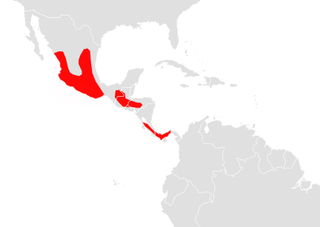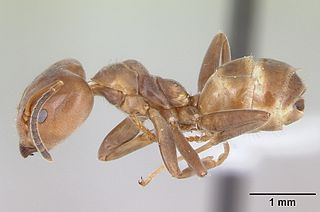
Televisión Azteca, S.A.B. de C.V., commonly known as TV Azteca, is a Mexican multimedia conglomerate owned by Grupo Salinas. It is the second-largest mass media company in Mexico after Televisa. It primarily competes with Televisa as well as some local operators. It owns two national television networks, Azteca Uno and Azteca 7, and operates two other nationally distributed services, adn40 and A Más+. All three of these networks have transmitters in most major and minor cities.

Dolichoderinae is a subfamily of ants, which includes species such as the Argentine ant, the erratic ant, the odorous house ant, and the cone ant. The subfamily presents a great diversity of species throughout the world, distributed in different biogeographic realms, from the Palearctic, Nearctic, Afrotropical region and Malaysia, to the Middle East, Australian, and Neotropical regions.

Azteca América was an American Spanish-language free-to-air television network owned by INNOVATE Corp., which acquired the network from the Azteca International Corporation subsidiary of TV Azteca.

Cephalotes is a genus of tree-dwelling ant species from the Americas, commonly known as turtle ants. All appear to be gliding ants, with the ability to "parachute" and steer their fall so as to land back on the tree trunk rather than fall to the ground, which is often flooded.

Emeric Dembroschi is a retired Romanian football striker.

The Aztec fruit-eating bat is a species of bat in the family Phyllostomidae.

Acropyga is a genus of small formicine ants. Some species can be indirect pests. A. acutiventris, which is found from India to Australia, tends subterranean, root-feeding mealybugs of the species Xenococcus annandalei. Living, gravid females are carried in the jaws of A. acutiventris queens during their nuptial flight, to establish the symbiotic association in founding colonies. Other Acropyga species have relationships with different species of mealybugs, and it could be a trait common to the whole genus.

Dolichoderus is a genus of ants found worldwide.

Azteca is a strictly Neotropical genus of ants in the subfamily Dolichoderinae. The genus is very diverse and contains around 84 extant species and two fossil species. They are essentially arboreal and many species have mutualistic associations with particular plant species, where the genus Cecropia presents the most conspicuous association. In the Brazilian Amazonia, Azteca species are associated with species of Codonanthopsis.

Leptomyrmecini is a tribe of Dolichoderinae ants with 16 genera and two extinct genera.

Azteca alfari is a species of ant in the genus Azteca. Described by Carlo Emery in 1893, the species is widespread in Mexico, Central and South America. This ant has a mutualistic relationship with a Cecropia tree. The specific name alfari honours a Costa Rican zoologist Anastasio Alfaro.
Azteca angusticeps is a species of ant in the genus Azteca. Described by Carlo Emery in 1893, the species is widespread in North America and South America.
Azteca aurita is a species of ant in the genus Azteca. Described by Emery in 1893, the species is widespread in North America and South America.
Azteca beltii is a species of ant in the genus Azteca. Described by Carlo Emery in 1893, the species is endemic to North America and South America.

Azteca chartifex is a species of ant in the genus Azteca. Described by Forel in 1896, the species is endemic to various countries in North America and South America.

Azteca coeruleipennis is a species of ant in the genus Azteca. Described by Emery in 1893, the species is endemic to several countries in North America and Central America.
Azteca constructor is a species of ant in the genus Azteca. Described by Emery in 1896, the species is endemic to several countries in Central America and South America.
Azteca delpini is a species of ant in the genus Azteca. Described by Emery in 1893, the species is endemic to South America.
Azteca depilis is a species of ant in the genus Azteca. Described by Carlo Emery in 1893, the species is endemic to South America.

Azteca muelleri is a species of ant in the genus Azteca. Described by the Italian entomologist Carlo Emery in 1893, the species is native to Central and South America. It lives in colonies in the hollow trunk and branches of Cecropia trees. The specific name muelleri was given in honour of a German biologist Fritz Müller, who discovered that the small bodies at the petiole-bases of Cecropia are food bodies.













